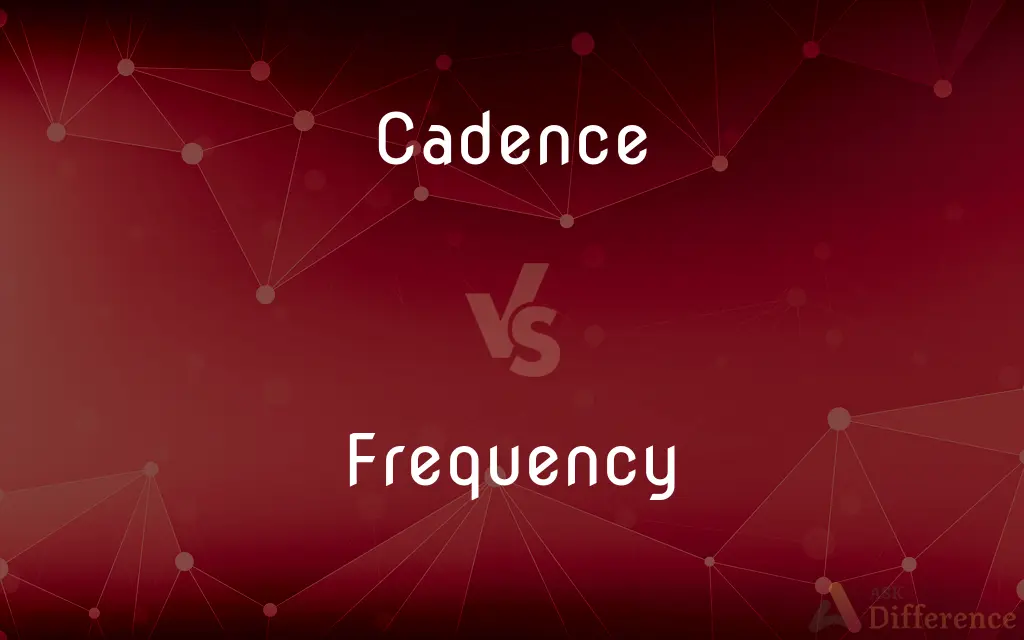Cadence vs. Frequency — What's the Difference?
By Urooj Arif & Fiza Rafique — Updated on March 22, 2024
Cadence refers to the rate at which sequence of events or motions occurs, often used in context with physical movements or music, while frequency measures how often something occurs per unit of time, typically used in physics to describe waves or cycles.

Difference Between Cadence and Frequency
Table of Contents
ADVERTISEMENT
Key Differences
Cadence is a term that can be applied to various contexts, such as cycling, running, music, and speech, describing the rhythm or flow of these activities. Frequency, on the other hand, is a quantitative measurement used primarily in the fields of physics and engineering to describe the number of cycles of a periodic phenomenon occurring in a specified period of time, usually a second.
While cadence often focuses on the pattern or rhythm of events in a more subjective manner, frequency provides a precise and objective rate of how often repetitive events occur over time. For instance, the cadence of a piece of music captures its rhythmic feel, whereas the frequency of a sound wave involves a specific count of vibrations per second, affecting the pitch of the sound heard.
In some contexts, cadence and frequency can intersect. For example, the cadence of a runner's steps might be described in steps per minute, somewhat akin to frequency, but it is typically understood in a broader sense to include the rhythm and flow of movement, not just the numerical rate.
Both cadence and frequency offer important but different insights into repetitive motions and phenomena. Cadence adds a layer of interpretation regarding the flow and rhythm of sequences, which is essential in artistic and physical activities, while frequency provides a foundational measurement for understanding and analyzing periodic phenomena in the scientific realm.
Comparison Chart
Definition
Rate at which a sequence of events or motions occurs, focusing on rhythm.
Number of occurrences of a repeating event per unit time, measured in Hertz (Hz).
ADVERTISEMENT
Context
Music, cycling, running, speech
Physics, sound waves, light waves
Measurement
Often qualitative, described in terms of rhythm or flow.
Quantitative, precisely measured in cycles per second.
Unit
Varies (e.g., RPM in cycling, chords in music)
Hertz (Hz)
Application
Tempo or rhythm of activities, subjective
Frequency of periodic phenomena, objective
Compare with Definitions
Cadence
The tempo or pace in running, often measured in steps per minute.
A running cadence of 180 steps per minute is considered optimal for reducing injury risk.
Frequency
Used to describe the pitch of sounds, based on vibration rates.
Higher frequency sounds have a higher pitch.
Cadence
Pattern of progression in music, creating a sense of resolution.
The song ended with a perfect cadence, bringing a satisfying conclusion.
Frequency
The rate at which a wave completes a cycle, measured in Hertz (Hz).
The frequency of middle C on a piano is 261.63 Hz.
Cadence
The rhythm or flow of events in music or speech.
The cadence of the poem contributed to its haunting atmosphere.
Frequency
Measurement in signal processing to analyze wave patterns.
Frequency analysis helps in identifying different components of a complex signal.
Cadence
The rate of pedal revolutions per minute in cycling.
Maintaining a cadence of 90 RPM helps cyclists improve efficiency.
Frequency
The number of occurrences of a repeating event per unit time.
The frequency of the heartbeats provides critical information about health.
Cadence
The flow of movement in dance or physical routines.
The dancer's cadence was perfectly synchronized with the music.
Frequency
The rate of electrical cycles in power systems, typically 50 or 60 Hz.
Household electrical power in the US operates at a frequency of 60 Hz.
Cadence
In Western musical theory, a cadence (Latin cadentia, "a falling") is the end of a phrase in which the melody or harmony creates a sense of resolution. A harmonic cadence is a progression of two or more chords that concludes a phrase, section, or piece of music.
Frequency
Frequency is the number of occurrences of a repeating event per unit of time. It is also occasionally referred to as temporal frequency to emphasize the contrast to spatial frequency, and ordinary frequency to emphasize the contrast to angular frequency.
Cadence
A modulation or inflection of the voice
The measured cadences that he employed in the Senate
Frequency
The rate at which something occurs over a particular period of time or in a given sample
An increase in the frequency of accidents due to increased overtime
Cadence
A sequence of notes or chords comprising the close of a musical phrase
The final cadences of the Prelude
Frequency
The rate per second of a vibration constituting a wave, either in a material (as in sound waves), or in an electromagnetic field (as in radio waves and light)
Different thicknesses of glass will absorb different frequencies of sound
Cadence
Balanced, rhythmic flow, as of poetry or oratory.
Frequency
The property or condition of occurring at frequent intervals.
Cadence
The measure or beat of movement, as in dancing or marching.
Frequency
The number of repetitions of a complete sequence of values of a periodic function per unit variation of an independent variable.
Cadence
A rhythmic chant, often in call-and-response form, used by soldiers to keep in step when marching or running.
Frequency
The number of complete cycles of a periodic process occurring per unit time.
Cadence
A falling inflection of the voice, as at the end of a sentence.
Frequency
The number of repetitions per unit time of a complete waveform, as of an electric current.
Cadence
General inflection or modulation of the voice.
Frequency
The number of measurements or observations having a certain value or characteristic.
Cadence
(Music) A progression of chords moving to a harmonic close, point of rest, or sense of resolution.
Frequency
See relative frequency.
Cadence
The act or state of declining or sinking.
Frequency
The rate of occurrence of anything; the relationship between incidence and time period.
With growing confidence, the Viking’s raids increased in frequency.
Cadence
Balanced, rhythmic flow.
Frequency
(uncountable) The property of occurring often rather than infrequently.
Cadence
The measure or beat of movement.
Frequency
(countable) The quotient of the number of times a periodic phenomenon occurs over the time in which it occurs: .
Cadence
The general inflection or modulation of the voice, or of any sound.
Frequency
(statistics) number of times an event occurred in an experiment (absolute frequency)
Cadence
(music) A progression of at least two chords which conclude a piece of music, section or musical phrases within it. Sometimes referred to analogously as musical punctuation.
Frequency
The condition of returning frequently; occurrence often repeated; common occurence; as, the frequency of crimes; the frequency of miracles.
The reasons that moved her to remove were, because Rome was a place of riot and luxury, her soul being almost stifled with, the frequencies of ladies' visits.
Cadence
(music) A cadenza, or closing embellishment; a pause before the end of a strain, which the performer may fill with a flight of fancy.
Frequency
A crowd; a throng.
Cadence
(speech) A fall in inflection of a speaker’s voice, such as at the end of a sentence.
Frequency
The number of occurrences within a given time period (usually 1 second);
The frequency of modulation was 40 cycles per second
Cadence
(dance) A dance move which ends a phrase.
The cadence in a galliard step refers to the final leap in a cinquepace sequence.
Frequency
The ratio of the number of observations in a statistical category to the total number of observations
Cadence
(fencing) The rhythm and sequence of a series of actions.
Frequency
The number of observations in a given statistical category
Cadence
(running) The number of steps per minute.
Cadence
(cycling) The number of revolutions per minute of the cranks or pedals of a bicycle.
Cadence
(military) A chant that is sung by military personnel while running or marching; a jody call.
Cadence
(heraldry) cadency
Cadence
(horse-riding) Harmony and proportion of movement, as in a well-managed horse.
Cadence
(horseracing) The number of strides per second of a racehorse, measured when the same foot/hoof strikes the ground
Cadence
(software development) The frequency of regular product releases.
Cadence
To give a cadence to.
Cadence
To give structure to.
Cadence
The act or state of declining or sinking.
Now was the sun in western cadence low.
Cadence
A fall of the voice in reading or speaking, especially at the end of a sentence.
Cadence
A rhythmical modulation of the voice or of any sound; as, music of bells in cadence sweet.
Blustering winds, which all night longHad roused the sea, now with hoarse cadence lullSeafaring men o'erwatched.
The accents . . . were in passion's tenderest cadence.
Cadence
Rhythmical flow of language, in prose or verse.
Golden cadence of poesy.
If in any composition much attention was paid to the flow of the rhythm, it was said (at least in the 14th and 15th centuries) to be "prosed in faire cadence."
Cadence
See Cadency.
Cadence
Harmony and proportion in motions, as of a well-managed horse.
Cadence
A uniform time and place in marching.
Cadence
The close or fall of a strain; the point of rest, commonly reached by the immediate succession of the tonic to the dominant chord.
Cadence
To regulate by musical measure.
These parting numbers, cadenced by my grief.
Cadence
(prosody) the accent in a metrical foot of verse
Cadence
The close of a musical section
Cadence
A recurrent rhythmical series
Common Curiosities
How does the concept of cadence apply to writing or speech?
In writing or speech, cadence refers to the rhythmic flow of words or phrases, influencing readability, comprehension, and the listener's or reader's emotional response.
Is there a difference between the cadence of an activity and its frequency?
Yes, cadence focuses more on the pattern and rhythm of an activity, while frequency precisely measures how often an event occurs within a specific timeframe.
What is cadence used for?
Cadence is used to describe the rhythm, flow, or tempo of various activities, such as music, cycling, running, and speech, emphasizing the pattern and pace of these actions.
How is frequency measured?
Frequency is measured in Hertz (Hz), indicating the number of cycles per second of a periodic event or wave.
Can cadence and frequency be related?
In some contexts, cadence and frequency can intersect, such as in describing the pace of physical activities in units per minute, but cadence often carries additional qualitative aspects related to rhythm and flow.
Why is frequency important?
Frequency is crucial for understanding and analyzing periodic phenomena in science and engineering, affecting how sound is perceived, how light is visible, and how electronic devices operate.
What role does frequency play in music?
Frequency determines the pitch of notes in music; higher frequencies correspond to higher pitches, allowing for the creation of melodies and harmonies.
How does cadence affect physical performance?
Cadence can significantly affect physical performance by optimizing efficiency, reducing injury risk, and improving endurance. For instance, in cycling and running, finding an optimal cadence can help athletes maintain better form and use their energy more effectively.
What factors influence the frequency of a sound wave?
The frequency of a sound wave is influenced by the source of the sound, including the speed of vibration of the object producing the sound. In musical instruments, for example, the length, thickness, and tension of strings can affect the frequency of the notes they produce.
Why is understanding frequency important in telecommunications?
In telecommunications, understanding frequency is essential for transmitting and receiving signals without interference. Different frequencies allow for the multiplexing of signals, enabling the simultaneous transmission of data over a single communication medium, thereby optimizing the use of available bandwidth and reducing cross-talk.
Can the human ear detect all frequencies?
The human ear can typically detect frequencies ranging from 20 Hz to 20,000 Hz. Sounds outside this range, such as infrasound (below 20 Hz) and ultrasound (above 20,000 Hz), are not perceivable by humans but can be detected by various animals and technological devices.
How do changes in cadence impact energy consumption in activities like cycling or running?
Changes in cadence can lead to variations in energy consumption. For instance, a higher cadence in cycling might reduce muscle fatigue by using more aerobic energy, while a lower cadence uses more muscular energy, which can lead to quicker fatigue. Finding an individual's optimal cadence is crucial for maximizing performance and efficiency.
Share Your Discovery

Previous Comparison
Hell vs. Perdition
Next Comparison
Challenge vs. BarrierAuthor Spotlight
Written by
Urooj ArifUrooj is a skilled content writer at Ask Difference, known for her exceptional ability to simplify complex topics into engaging and informative content. With a passion for research and a flair for clear, concise writing, she consistently delivers articles that resonate with our diverse audience.
Co-written by
Fiza RafiqueFiza Rafique is a skilled content writer at AskDifference.com, where she meticulously refines and enhances written pieces. Drawing from her vast editorial expertise, Fiza ensures clarity, accuracy, and precision in every article. Passionate about language, she continually seeks to elevate the quality of content for readers worldwide.















































